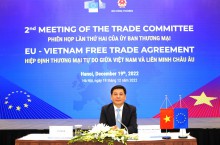The News
Trade policy updates in Indonesia
Since 1 January 2017, Indonesia's Customs Import Tariff Schedule has been based on the 2017 version of the Harmonized Commodity Description and Coding System (HS). The current Schedule, which is available online also in English (https://intr.insw.go.id/tariff.php?id=1&pg=1), consists of 10,813 eight-digit tariff lines (HS2017 nomenclature), and contains 801 more than the HS 2012 version (10,012 ten-digit tariff lines). It has a single set of rates, i.e. the MFN rates applied to goods from WTO Members, or to economies that accord reciprocal treatment to Indonesia.
Since 1 January 2017, Indonesia's Customs Import Tariff Schedule has been based on the 2017 version of the Harmonized Commodity Description and Coding System (HS). The current Schedule, which is available online also in English (https://intr.insw.go.id/tariff.php?id=1&pg=1), consists of 10,813 eight-digit tariff lines (HS2017 nomenclature), and contains 801 more than the HS 2012 version (10,012 ten-digit tariff lines). It has a single set of rates, i.e. the MFN rates applied to goods from WTO Members, or to economies that accord reciprocal treatment to Indonesia.
Since 1 January 2017, Indonesia's Customs Import Tariff Schedule has been based on the 2017 version of the Harmonized Commodity Description and Coding System (HS). The current Schedule, which is available online also in English (https://intr.insw.go.id/tariff.php?id=1&pg=1), consists of 10,813 eight-digit tariff lines (HS2017 nomenclature), and contains 801 more than the HS 2012 version (10,012 ten-digit tariff lines). It has a single set of rates, i.e. the MFN rates applied to goods from WTO Members, or to economies that accord reciprocal treatment to Indonesia.

Indonesia's simple average applied MFN tariff rate rose from 7.8% in 2012 to 10.1% in 2020, mainly due to an increase in duty rates on a number of products and the splitting of tariff lines (e.g. transport equipment (HS Section 17)) resulting from the tariff nomenclature change. Indonesia amended its Customs Tariff to, inter alia, introduce HS2017 changes. Products that benefited from tariff reductions include auxiliary plant for use with boilers (HS84.04). Products that were subject to tariff increases include coffee and tea (HS09), preparations of meat and fish (HS Chapter 16), sugar confectionary not containing cocoa (HS17.04), leather articles (HS Chapter 42), wood articles (HS Chapter 44), cotton (HS Chapter 52), textiles and clothing, carpets and other textile coverings (HS57.02), worn clothing (HS 63.09), footwear (HS Chapter 64), iron and steel (HS Chapter 72), and motor vehicles (HS87.02 and 87.03). Furthermore, the applied tariff rates for a range of goods that reportedly compete with locally manufactured products, including electronic products, electrical and non-electrical milling machines, chemicals, cosmetics, medicines, wine and spirits, iron wire and wire nails, and some agricultural products including milk products, animal and vegetable oils, fruit juices, coffee and tea, were also raised.
For consumer goods purchased through e-commerce channels, the Indonesian Government has lowered the threshold of goods value to be imposed import taxes on consumer goods bought and sold through e-commerce - from 75 USD to only 3 USD (about 42,000 USD). Rp), aimed at protecting domestic small businesses.
Under Law No. 7/2014, Indonesia's policy objective has been to structure licensing procedures for the smooth flow of goods. According to the authorities, Indonesia simplified import (and export) licensing through online and digital signature, thus improving its efficiency and centralization.
Import licensing requirements remain in place for a number of reasons (see above), including to prevent smuggling and to implement policies aimed at protecting and/or promoting domestic production. During the review period, the regulatory framework of import licensing was expanded and revised for several items, including: animals and animal products; cloves; sugar; horticultural products; alcoholic beverages; salt; pearls; lubricants; plastic; nitro cellulose; sodium triopoly-phosphate; ozone-depleting substances; non-hazardous and non-toxic waste; optical discs (empty and filled) and machines and materials used to produce them; textiles and textile products; cell phones, handheld computers, and tablets; and colour multi-functional machines, colour photocopying and printing machines.



